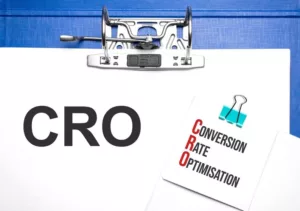An astonishing 61% of businesses experiment with their landing pages up to five times a month as their CRO strategy.
This underscores the significance of meticulous attention to detail and the strategic implementation of Conversion Rate Optimization (CRO) techniques to propel your business to new heights.
In this article, we will delve into the intricacies of CRO, elucidating its profound benefits for your business. We will also provide a comprehensive 100-day roadmap designed to improve your conversion rates.
Read until the end to replicate this CRO strategy that has facilitated numerous businesses to transcend to nine-figure revenue.
What is CRO (Conversion Rate Optimization)?

Conversion Rate Optimization (CRO) is improving your website or digital platform to increase the percentage of visitors who take a desired action or “convert” into your customers, leads, and subscribers. It helps you optimize your user experience and remove barriers that prevent visitors from completing your desired action. Ultimately, it maximizes your return on investment (ROI) from existing website traffic.
8 Surefire Benefits of CRO Strategies and Techniques for Businesses

Conversion optimization for small business website to enterprise-grade drive business success and maximizes the potential of your online venture. It offers your users a seamless experience, converts them, and transitions them into lifelong customers.
Below are the exclusive benefits that CRO brings to your business.
Increased Conversion Rates
Conversion Rate Optimization (CRO) strategies improve your conversion rates. All you need to do is pay attention to detail and optimize CTAs, landing pages, and checkout processes. So your user can easily be navigated and influenced to take your desired actions.
Improved Return on Investment (ROI)
CRO strategies help your business achieve a higher return on investment for your marketing efforts. By converting a higher percentage of existing website traffic into customers or leads, you can optimize the value of your marketing spend and generate more revenue without necessarily increasing your budget.
Better Understanding of Customer
CRO encourages garnering user feedback, surveys, and behavior tracking, which offers you valuable insights into your target audience. Through this enhanced understanding, you can tailor your marketing messages and offers to better resonate with your customers. Ultimately, you can give your customers a personalized experience and gain their loyalty.
Enhanced User Experience
Using CRO strategies, you can offer a better user experience for your website visitors. This leads to improved customer satisfaction, increased trust in your brand, and a positive impact on customer loyalty and retention. On the flip side, it will also reduce bounce rates and increase engagement.
Reduced Customer Acquisition Cost (CAC) Costs
Conversion Rate Optimization (CRO) reduces your Customer Acquisition Costs by optimizing landing pages, CTAs, and user flow and offering an engaging user experience. So you can allocate your marketing budget more effectively and achieve a better return on investment (ROI).
Maximum Tracking of Your Marketing Activities
CRO strategies involve A/B testing, heatmaps, and user session recordings, providing valuable data on how visitors interact and respond to your website. This granular tracking enables you to identify which marketing efforts are most effective, which areas need improvement, and which initiatives lead to the highest conversions.
Data-Driven Decision Making
Since CRO strategy involves rigorous testing and analysis, it provides valuable data and insights about your website and customers. You can use this data to refine your strategies, optimize performance, and make informed decisions.
Competitive Advantage
Effective CRO strategies give your business a competitive edge in the market. By constantly improving and refining your website’s performance, you can stand out from competitors and attract more customers. Ultimately, this will lead you to long-term growth and success.
Your Business’s First 100 Day Strategies For CRO

The first 100 days lay a strong foundation and make significant improvements in your website’s performance. However, you need to follow a dedicated CRO process during this period. Let’s now dive into the detailed CRO process and strategies for your business.
Preparing for CRO Implementation
Preparing for Conversion Rate Optimization (CRO) implementation ensures that your efforts are focused and well-coordinated. It also yields significant improvements in your website’s performance. Here’s how you can prepare for CRO implementation:
Conduct a Website Audit and Usability Analysis
Before diving into CRO strategies, understand your website’s current state comprehensively. Perform a website audit and usability analysis to identify areas that need improvement, like:
a. Website Design and Layout
- Evaluate the overall design aesthetics and branding consistency.
- Ensure that your website is visually appealing and user-friendly.
- Check for cluttered layouts and elements that might distract your visitors.
b. Navigation and User Flow
- Analyze your website’s navigation menus and structure.
- Ensure your users can easily find what they are looking for.
- Identify dead-ends or confusing paths in the user journey.
c. Potential Friction Points
- Look for elements that may cause friction in your conversion process.
- Check for technical issues, slow page load times, or broken links.
- Identify any barriers that might prevent your users from completing desired actions.
Set Clear and Measurable CRO Objectives
One of the top conversion optimization tips is to define clear and specific CRO objectives that align with your overall business goals. These objectives will serve as the foundation for your CRO strategy. Key considerations include:
a. Conversion Goals
- Determine the primary conversions you want to focus on, like sales, lead generation, or email sign-ups.
- Establish secondary conversions that contribute to your main goals, like newsletter subscriptions or downloads.
b. Key Performance Indicators (KPIs)
- Identify relevant KPIs that measure the success of your CRO efforts.
- Examples of KPIs include conversion rate, bounce rate, average session duration, and cart abandonment rate.
c. Benchmark Targets
- Set realistic benchmark targets for each KPI to track progress.
- Use historical data and industry benchmarks to establish achievable goals.
Assemble a Dedicated CRO Team
Successful CRO strategy implementation requires collaboration and expertise from different departments. Depending on the size of your organization, you can either form a dedicated CRO team or identify responsible stakeholders for this initiative.
a. CRO Team Roles and Responsibilities
- Consider including individuals from your marketing, design, development, and data analytics teams.
- Designate a CRO manager or coordinator to oversee your process and communication.
b. Cross-Functional Collaboration
Ensure your team members work cohesively to achieve common CRO objectives.
Facilitate regular meetings to share insights and progress updates.
Allocate Resources and Budget for CRO Initiatives
CRO implementation requires additional resources, tools, and even budget allocation for A/B testing platforms or user research tools. Evaluate and allocate the necessary resources to support your CRO efforts effectively.
Implement User Feedback Mechanisms
Gather valuable insights from your customers through surveys, feedback forms, or live chat interactions. Understanding customer pain points and preferences will help you identify areas that need improvement and guide your CRO strategies.
Establish a Baseline for Future Comparison
Record your website’s current performance metrics before starting your CRO initiatives. This baseline data will serve as a point of comparison to measure the impact of your CRO efforts over time.
Day 1-10: Understanding Your Audience and Analytics
understand your targeted audience during the first ten days of your Conversion Rate Optimization (CRO) journey. Gather valuable insights from website analytics. This foundation will shape your subsequent CRO strategies and ensure they align with your customer’s needs and preferences.
Conducting In-Depth Audience Research and Creating Buyer Personas
a. Analyzing Customer Demographics and Behaviors
- Utilize tools like Google Tag Manager, Microsoft Clarity, Hotjar, Mixpanel, Optimizely, or Google Analytics 4 to identify key demographics of your website visitors, including age, gender, location, and interests.
- Analyze your user behavior, considering the most visited pages, bounce rates, and average session duration.
b. Gathering Feedback Through Surveys and Interviews
- Create online surveys to collect direct feedback from your website visitors about their experiences, pain points, and expectations.
- Conduct user interviews to gain qualitative insights into their motivations and decision-making processes.
c. Creating Detailed Buyer Personas for Targeting
- Use the collected data to create buyer personas representing your typical customers.
- Define their goals, challenges, preferences, and the unique value your business offers them.
Analyzing Existing Website Analytics and User Behavior
a. Utilizing Tools like Google Analytics to Gather Data
- Install Google Analytics to track user behavior on your website.
- Set up conversion tracking to measure the success of your specific actions. For instance, completing purchases or sign-ups.
b. Identifying High-Traffic Pages and Top Entry Points
- Identify pages that receive the most traffic and have the highest potential for conversions.
- Determine the top entry points through which visitors arrive on your site to understand their intent.
c. Understanding User Journey and Behavior Flow
- Analyze the typical user journey from entry to conversion and identify drop-off points or pages with high exit rates.
- Understand how users navigate through your website and identify areas where they might encounter obstacles.
Day 11-20: Defining Key Performance Indicators (KPIs)
During days 11 to 20, you will define your Key Performance Indicators (KPIs) to measure the success of your CRO strategy and establish benchmark targets for each metric.
Determining Conversion Goals
a. Identify Primary Conversions
- Decide on the main conversions that align with your business objectives, like product purchases, form submissions, or account registrations.
b. Establish Secondary Conversions
- Identify secondary conversions that contribute to the main goals, such as newsletter sign-ups or social media follows.
Identifying Relevant KPIs
a. Conversion Rate
- Calculate the percentage of your website visitors who complete the desired conversion action.
b. Bounce Rate
- Measure the percentage of users who leave your website after viewing only one page.
c. Average Session Duration
- Determine the average time users spend on your website per session.
d. Cart Abandonment Rate
- Calculate the percentage of users who add items to their shopping cart but do not complete the purchase.
Setting Benchmark Targets for KPIs
a. Use Historical Data and Industry Benchmarks
- Analyze historical data to understand your current performance for each KPI.
- Research industry benchmarks to set realistic and achievable targets.
b. Establish Specific Targets
- Set specific numerical targets for each KPI to measure your progress over time.
- Ensure that the targets are challenging yet attainable within the given timeframe.
Day 21-40: Implementing Quick Wins and A/B Testing
From day 21 to 40, implement quick wins and conduct A/B testing to identify high-impact changes that can improve your conversion rates immediately.
Identifying Quick Wins
a. Address Low-Hanging Fruit
- Identify elements on your website that can be easily optimized with minimal effort but significantly impact conversions.
- Examples include improving CTA buttons, refining headline copy, or adding trust signals.
b. Address High-Exit Pages
- Identify pages with high exit rates and focus on improving their content, layout, or navigation to keep your users engaged.
Conducting A/B Testing
a. Formulating Test Hypotheses
- Create clear and specific hypotheses for each A/B test based on identified areas for improvement.
- Ensure that each hypothesis has a measurable and actionable goal.
b. Designing A/B Tests
- Create variations for CTAs, button colors, or page layouts.
- Use A/B testing tools to ensure a random distribution of traffic between variations.
c. Analyzing and Interpreting Test Results
- Allow each A/B test to run for an appropriate duration to gather statistically significant data.
- Analyze the results to determine which variation performs better in terms of the defined KPIs.
d. Implementing Insights from A/B Testing
- Implement the winning variations from A/B tests to make data-driven improvements to your website.
- Learn from unsuccessful tests and use the insights to refine your future CRO strategies.
Day 41-60: Enhancing Website User Experience (UX)
Enhance your website’s user experience and tailor it to the ideal CRO web design from day 41 to 60. It will create a seamless and delightful journey for your visitors, increasing your conversion rates and customer satisfaction.
Conducting a Comprehensive UX Analysis
a. Evaluate Website Navigation and Layout
- Ensure that your website has clear navigation menus and a logical structure that guides users to the information or products they seek.
- Streamline your layout to reduce clutter and improve visual hierarchy.
b. Optimizing Page Load Times and Mobile Responsiveness
- Optimize images and other media files to reduce your page load times.
- Ensure that your website is mobile-responsive and offers a smooth experience on all devices.
Improving Website Content and Messaging
a. Crafting Clear and Engaging Content
- Use compelling and concise copy that clearly communicates your value proposition and benefits.
- Use persuasive language to guide your users toward conversions.
b. Addressing User Pain Points
- Analyze user feedback and identify common pain points or frequently asked questions.
- Address these pain points in your content and provide solutions to build trust and credibility.
Enhancing CTA (Call-to-Action) Design
a. Creating Attention-Grabbing CTAs
- Use contrasting colors and eye-catching designs for your CTAs so they stand out.
- Make sure CTAs are placed strategically on pages with relevant content.
b. Utilizing Action-Oriented Copy
- Use action-oriented language in your CTAs to encourage your users to take the desired action.
- Experiment with different CTA copies to see which variations perform best.
Day 61-70: Leveraging Social Proof and Testimonials
Day 61 to 70 of the CRO strategy is usually dedicated to leveraging social proof and customer testimonials. It will help you build trust and credibility, which can significantly impact conversion rates.
Collecting and Showcasing Customer Testimonials and Reviews
a. Encouraging Customer Feedback
- Request customer reviews and testimonials through email or post-purchase surveys.
- Incentivize customers to leave feedback with discounts or loyalty rewards.
b. Displaying Testimonials Strategically
- Showcase customer testimonials prominently on high-converting pages or product/service pages.
- Use compelling visuals and include customer names and photos (with permission) for authenticity.
Implementing Social Proof Elements
a. Displaying Social Media Followers and Engagements
- Highlight the number of your social media followers. Share your brand has strong popularity and trustworthiness.
- Use social media widgets or counters to showcase real-time engagement.
b. Featuring Influencer Endorsements
- Collaborate with influencers or industry experts to promote your products or services.
- Highlight their endorsements on your website to add credibility.
Creating Case Studies and Success Stories
a. Collecting and Analyzing Customer Success Stories
- Identify customers who have achieved significant results or experienced positive outcomes using your product or service.
- Conduct interviews or surveys to gather detailed information about their success.
b. Presenting Compelling Case Studies
- Create visually appealing case studies that showcase the challenges faced by customers, the solutions provided, and the results achieved.
- Demonstrate the value of your offerings through real-life examples.
Day 71-80: Personalization and Targeting CRO Strategies
Plan on offering a tailored experience to every user landing on your website from Days 71 to 80. Segment your audience for a personalized experience.
Utilizing Dynamic Content Based on User Behavior and Preferences
a. Implementing Behavioral Tracking
- Use cookies and tracking tools to monitor user behavior on your website.
- Analyze their interactions to understand their preferences and interests.
b. Customizing Content and Recommendations
- Show personalized content, product recommendations, or offers based on your user’s previous interactions.
- Use dynamic landing pages to tailor your content according to user segments.
Tailoring Offers and Promotions to Specific Customer Segments
a. Segmentation Based on Customer Data
- Segment your audience based on demographics, behavior, or purchase history.
- Use CRM data to personalize your communication and offerings.
b. Sending Targeted Email Campaigns
- Create personalized email campaigns for different customer segments.
- Use dynamic email content to display relevant products or content.
Implementing Personalized Recommendations and Product Suggestions
a. Product Recommendation Engines
- Integrate product recommendation engines on your website or eCommerce platform.
- Show related products or items frequently bought together to boost cross-selling.
b. Personalized Content Based on User Preferences
- Offer content suggestions based on your users’ reading habits or content consumption history.
- Provide options to customize email subscriptions to match individual preferences.
Day 81-90: Reducing Friction in the Conversion Process
Days 81 to 90 are critical and are dedicated to streamlining your conversion process. Now, you need to eliminate barriers and make it smooth and frictionless for your users to complete desired actions.
Streamlining the Checkout Process
a. Implementing Guest Checkout
- Allow your users to complete purchases without creating an account.
- Offer guest checkout as an option to reduce friction and increase your conversion rates.
b. Simplifying Payment and Shipping Options
- Provide multiple payment options to accommodate diverse customer preferences.
- Display transparent shipping costs and delivery times upfront to avoid surprises.
Reducing Cart Abandonment
a. Implementing Exit-Intent Popups
- Use exit-intent popups to offer discounts or incentives when your users attempt to leave the website with items in their cart.
- Encourage them to reconsider their decision and complete the purchase.
b. Sending Abandoned Cart Emails
- Automatically send reminder emails to users who abandon their carts, encouraging them to return and complete the purchase.
- Use personalized subject lines and content to capture their attention.
Simplifying Form Fills and Data Entry
a. Minimizing Required Fields
- Reduce the number of mandatory form fields to make the signup or checkout process quick and effortless.
- Use smart form design to hide unnecessary fields until they become relevant.
b. Implementing Autofill and Autocomplete
- Enable autofill and autocomplete features to make data entry quicker and more convenient for your users.
- Utilize browser features to pre-fill known information, like addresses and payment details.
Day 91-100: Evaluating CRO Success and Establishing Ongoing Strategies
During the last ten days, it’s time to evaluate the success of your CRO strategy and efforts. Measure the impact on KPIs, and establish a roadmap for ongoing optimization.
Measuring the Impact of Implemented CRO Strategies on KPIs
a. Analyzing A/B Testing Results
- Evaluate the performance of A/B test variations and identify the most successful changes.
- Calculate the uplift in conversion rates and other relevant KPIs.
b. Comparing with Benchmark Targets
- Compare the achieved KPIs with the benchmark targets set earlier in the process.
- Identify areas where you have exceeded or fallen short of expectations.
Identifying Areas for Further Optimization and Improvement
a. Analyzing User Feedback and Behavior
- Review user feedback collected during the first 100 days and identify recurring themes or pain points.
- Look for areas where user behavior indicates potential for improvement.
b. Conducting Heatmap and User Session Analysis
- Utilize heatmap tools and user session recordings to understand how users interact with specific elements on your website.
- Use this data to optimize key pages and call to action.
Roadmap for Ongoing CRO Strategies & Efforts Beyond the First 100 Days
Once you follow the 100 days optimization plan, continuously tracking the response and result will help you increase your conversion rate exponentially.
a. Establishing a CRO Calendar
- Plan regular CRO activities and testing cycles for the upcoming months.
- Allocate resources and time for future optimization efforts.
b. Continuously Implementing CRO Best Practices
- Stay updated with the latest CRO trends and best practices to stay ahead of the competition.
- Continuously optimize and refine your website to maintain a competitive edge.
Drive Higher Conversion Rates With Hired CRO Experts of VinnCorp
Finding the best CRO experts for hire? You’ve got a piece of good news. VinnCorp is a remote talent company that provides you with Silicon Valley CRO experts.
With a rich background in attention to detail and a proven track record in transitioning business nine figures and beyond, we help you make record-breaking sales. We understand your goals, analyze your website, devise a functional CRO strategy, and implement it. Additionally, we monitor and analyze to understand the best-performing strategy and use it across your entire website.
Contact us today and book CRO experts for your project.



